大学英语语法精讲与练习.doc
2025高考英语步步高大一轮复习讲义人教版必修第二册——选择性必修第四册语法专题答案精析
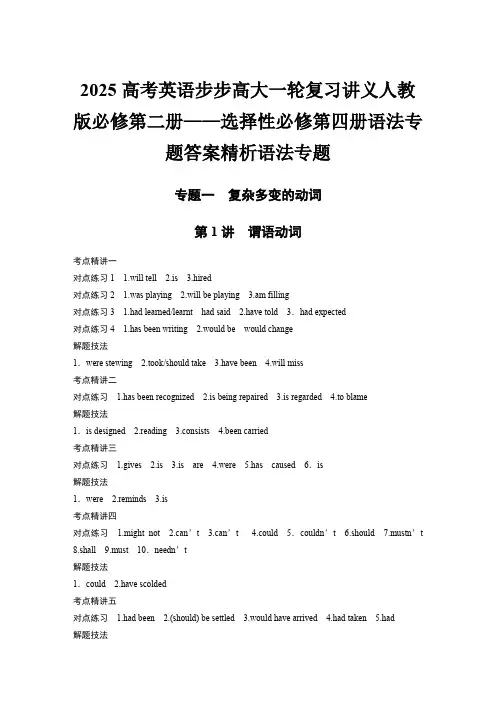
2025高考英语步步高大一轮复习讲义人教版必修第二册——选择性必修第四册语法专题答案精析语法专题专题一复杂多变的动词第1讲谓语动词考点精讲一对点练习1 1.will tell 2.is 3.hired对点练习2 1.was playing 2.will be playing 3.am filling对点练习3 1.had learned/learnt had said 2.have told3.had expected对点练习4 1.has been writing 2.would be would change解题技法1.were stewing 2.took/should take 3.have been 4.will miss考点精讲二对点练习 1.has been recognized 2.is being repaired 3.is regarded 4.to blame解题技法1.is designed 2.reading 3.consists 4.been carried考点精讲三对点练习 1.gives 2.is 3.is are 4.were 5.has caused6.is解题技法1.were 2.reminds 3.is考点精讲四对点练习 1.might not 2.can’t 3.can’t 4.could5.couldn’t 6.should7.mustn’t 8.shall9.must10.needn’t解题技法1.could 2.have scolded考点精讲五对点练习 1.had been 2.(should) be settled 3.would have arrived 4.had taken 5.had解题技法1.wouldn’t be 2.would stop 3.(should) get 4.focused考点分层演练层级一1.was working 2.have kept 3.had sunk 4.have been made5.was brought 6.is being taken 7.will be distributed8.is designed9.was listed10.have become层级二1.be employed 2.means 3.have promised 4.was fixing 5.threw 6.was built7.connects 8.had been offered9.will deliver/will be delivering10.are being displayed层级三Passage 11.was established 2.built 3.consisted 4.were replaced 5.(were) kept 6.understood7.have tried/have been trying8.to save9.(are) watched10.are playingPassage 21.needn’t 2.danced 3.can 4.did/should do 5.will6.(should) not allow7.must 8.didn’t wear9.shall10.should语法链接写作1.Though I felt a little sorry that you left China last year,I am pleased to know you are leading a happy life in your hometown.2.If you are available next Sunday,I will wait for you at the school gate and I’m sure we will have a good time together.3.It can easily be seen that the percentage of students who choose listening to English songs and watching English movies is respectively 65% and 50%.4.(1)If I hadn’t read the newspaper Youth,I wouldn’t have made such great progress in English.(2)In a word,it is high time that we should raise/raised our awareness of environmental protection.(3)It is required that anyone who wants to participate should arrive at the lecture hall on time to watch the movie and take part in the discussion.(4)But for/Without her help and professional instruction,I couldn’t have made such great progress in English study.5.From the learning experience,I fully understand that only by practicing a lot can we overcome many kinds of difficulties.第2讲非谓语动词考点精讲一对点练习 1.to have 2.carried 3.having completed 4.to have been robbed 5.being settled考点精讲二对点练习 1.to walk cated 3.forming 4.thinking5.getting 6.encouraging考点精讲三对点练习 1.being discussed 2.to support 3.marked4.living考点精讲四对点练习 1.making 2.to teach 3.permitting pleted 5.absorbed考点精讲五对点练习 1.smoking 2.delivered 3.to process解题策略1.Knowing 2.Being offered 3.to have received 4.Having been shown 5.making考点分层演练层级一1.being charged 2.applied 3.desiring 4.to be cheered5.Having suffered 6.absorbed 7.associated8.to master9.driven10.putting层级二1.borrowing intended 2.built 3.Having visited recording4.to continue 5.to journey 6.held 7.planning8.To strengthen inviting9. Covering10.to see层级三1.Going 2.are 3.refreshed 4.amazing 5.gets 6.astonished7.wondering8.to put 9.aching10.to visit语法链接写作1.Persuading him into accepting my views was impossible,so I didn’t want to waste my time discussing.2.(1)Hearing of the unexpected news,she was so surprised that she froze with her mouth wide open.(2)Worn out,David reached the finishing line and all the students cheered for him.3.To learn English more efficiently,you had better choose the Listening and Speaking course. 4.Having sold out all the popcorn,they decided to call it a day and go home.专题二需要变形的名词、数词、形容词和副词第1讲名词考点精讲一对点练习 1.championships 2.activities 3.weaknesses4.passersby 5.heroes 6.barber’s 考点精讲二对点练习 1.Word word 2.experiences experience 3.a/考点精讲三对点练习 1.arrival 2.invitation 3.responsibility 4.marriage 5.accuracy解题策略1.requirement professions 2.pollution 3.conditions4.dishes第2讲数词对点练习 1.thirteenth 2.thirds 3.ninth 4.twenties5.thousands解题技法1.second 2.has been polluted 3.fifth第3讲形容词和副词考点精讲一对点练习 1.personal 2.disappointed 3.amazing 4.hungry 5.highly 6.officially 7.Luckily8.terribly考点精讲二对点练习 1.more 2.wider 3.biggest 4.faster 5.as/so解题策略1.smaller 2.tasty 3.finest 4.gently考点分层演练层级一1.carrots 2.achievement 3.intention 4.fifties 5.twelfth6.third7.industrial8.surprising rgest10.widely层级二1.sixth 2.Different 3.warning 4.remarkable 5.rarely6.visiting7.interviews 8.Basically9.photographer10.meaningful层级三1.dynastic 2.classes 3.originally 4.closer 5.wealthy6.beautifully7.spacious 8.simpler/more simple9.cultural10.events语法链接写作1.When it comes to ocean,it’s of great importance to the world;however,its pollution isbecoming more and more serious.2.Last weekend,I participated in a “Getting to Know the Plants Around Us” activity organised by our Student Council with curiosity.3.(1)As you know,the more people are involved,the better the ocean environment is.(2)Nothing is more important than my teacher’s encouragement.Without it,I couldn’t have won the prize.专题三不可忽视的小词第1讲冠词考点精讲一对点练习 1.a 2.an 3.a 4.a考点精讲二对点练习 1.the 2.the 3.the 4.The 5.The考点精讲三解题策略1.a 2.the第2讲代词考点精讲一对点练习 1.himself 2.our 4.it 5.it 6.It考点精讲二对点练习 1.other 2.another 3.none 4.neither 5.one解题策略1.mine 2.their 3.herself 4.it第3讲介词对点练习 1.on 2.with 3.by 4.in 5.for 6.on解题技法1.by 2.for 3.in考点分层演练层级一1.an 2.the 3.the 4.his 5.them 6.myself7.it8.their9.on10.like层级二1.the 2.as 3.to 4.by 5.a 6.the7.by8.its9.the10.neither层级三1.a 2.their 3.of 4.for 5.with 6.a7.them8.her9.the10.by语法链接写作1.Because I am attracted by the contents,reading Youth becomes a must for me every day.2.It was exciting to learn that I had gained first prize and an award ceremony would be held in three days.3.Although online learning makes it easier for people to gain knowledge,being online is also a challenge for people who lack selfdiscipline.4.Eventually,because of my persistence and painstaking efforts,I could skate freely all by myself.专题四三大从句与特殊句式第1讲定语从句考点精讲一对点练习 1.which/that 2.whose 3.is 4.As 5.that6.which考点精讲二对点练习 1.when 2.where 3.which 4.why考点精讲三对点练习 1.which 2.whom 3.them 4.which解题策略1.which/that 2.where 3.who/that 4.whose 5.As考点分层演练层级一1.which 2.where 3.who 4.where 5.who/that 6.when7.whose8.As9.why 10.whom层级二1.which/that 2.where 3.who/that 4.who 5.that6.that 7.where8.whose9.which/that 10.where层级三1.when 2.why 3.where 4.whose 5.whom 6.that/which7.who8.which9.which 10.As语法链接写作1.运用1Confucius,also known as Kong Qiu,was a Chinese philosopher and politician who lived during the Spring and Autumn Period.运用2World Ocean Day which/that falls on June 8th is aimed at raising people’s awareness of ocean conservation.2.First,you’ll be shown around our school and have lunch at a local restaurant,where you can have a taste of authentic Chinese food.3.For students,what is most beneficial to their study is reading English books,from which they can learn what they can’t in class.4.To begin with,I suggest organizing a walking tour around the city to explore the green spaces in Beijing,which will allow participants to experience the beauty of the city’s parks.第2讲名词性从句对点练习 1.why 2.what 3.how 4.that 5.that6.whether解题技法1.What 2.how 3.whoever 4.where 5.whether/if考点分层演练层级一1.whether 2.why 3.how 4.what/whatever 5.where6.that7.What8.when9.who 10.because层级二1.why 2.whether/if 3.how 4.where 5.what 6.why/that7.what8.whether/if9.what 10.that层级三1.What 2.that 3.whether 4.why 5.How 6.who7.that8.that9.when10.because语法链接写作1.What surprised me was that my dad allowed me to use the money as I wished.2.No one can deny the fact that online learning is becoming more and more popular.3.I’m sorry that I can’t go out with you as planned.The reason is that my younger brother broke his leg the other day and I must look after him.4.The exhibition is fantastic and shows the charm of Chinese culture.This is why I would like to recommend my fellow students to attend this art show as well.5.I recommend that you (should) choose the Listening and Speaking course,because the course is entirely taught in Chinese,which will benefit you a lot.第3讲并列句和状语从句考点精讲一对点练习 1.while 2.when 3.or 4.but/yet 5.so考点精讲二对点练习 1.until 2.before 3.than 4.before 5.since考点精讲三对点练习 1.if 2.Wherever 3.as/though 4.that 5.because/as 6.that7.though/if8.how 解题策略1.and 2.While 3.because 4.before考点分层演练层级一1.that 2.because/as 3.but 4.and 5.when 6.while7.if8.though/although9.until/till 10.whatever层级二1.and 2.but/yet 3.or 4.because 5.whether 6.until/till7.or8.When/As9.if/though 10.unless层级三1.who/that 2.than 3.visiting 4.when 5.While/Though/Although 6.but7.higher8.If 9.for10.but语法链接写作1.Not only does the ocean offer us sufficient food,but it also maintains the balance of nature. 2.Come to the exhibition,and you will enjoy a visual feast.3.So difficult and painful for me was writing that my teacher had allowed me to present my paper on the sinking of the Titanic by acting out a play,where I played all the parts.4.We were looking for a place to put up the tent when Mother told us that she had forgotten to take it.5.Not until yesterday was I informed that our class was going to hold an important meeting this weekend—exactly the time when we shall meet.第4讲特殊句式考点精讲一对点练习 1.and 2.What 3.that考点精讲二对点练习 1.live 2.as/though 3.did 4.are 5.did考点精讲三对点练习 1.expected 2.writing 3.dealt 4.to make解题策略1.are 2.that考点分层演练层级一1.that 2.Sitting 3.warned 4.were 5.that 6.If层级二1.that 2.Were 3.that 4.did 5.came层级三1.a 2.that 3.without 4.continuing 5.permission6.logical7.were said8.further 9.Inspired10.whose语法链接写作1.What a fantastic Chinese painting show it is!2.“Hurry up,or the bear will catch up with us,” said Elli.3.It was at that festival that you shared so many interesting things about your country.4.Only when all the people make their efforts to protect the ocean will the ocean environment become better and better.5.So happy was Bernard that he gave John a big hug.6.In the backyard were two happy dogs tumbling about on the grassland.。
语法专攻高考英语一轮精讲精练英语句子结构和成分分析含详解 (1)
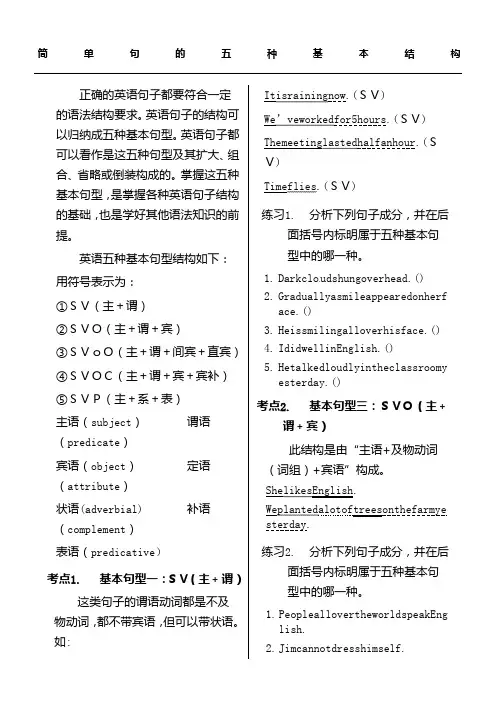
简单句的五种基本结构正确的英语句子都要符合一定的语法结构要求。
英语句子的结构可以归纳成五种基本句型。
英语句子都可以看作是这五种句型及其扩大、组合、省略或倒装构成的。
掌握这五种基本句型,是掌握各种英语句子结构的基础,也是学好其他语法知识的前提。
英语五种基本句型结构如下:用符号表示为:①SV(主+谓)②SVO(主+谓+宾)③SVoO(主+谓+间宾+直宾)④SVOC(主+谓+宾+宾补)⑤SVP(主+系+表)主语(subject)谓语(predicate)宾语(object)定语(attribute)状语(adverbial) 补语(complement)表语(predicative)考点1. 基本句型一:SV(主+谓)这类句子的谓语动词都是不及物动词,都不带宾语,但可以带状语。
如:Itisrainingnow.(SV)We’veworked for5hours.(SV) Themeetinglastedhalfanhour.(SV)Timeflies.(SV)练习1. 分析下列句子成分,并在后面括号内标明属于五种基本句型中的哪一种。
1.Darkcloudshungoverhead.()2.Graduallyasmileappearedonherface.()3.Heissmilingalloverhisface.()4.IdidwellinEnglish.()5.Hetalkedloudlyintheclassroomyesterday.()考点2. 基本句型三:SVO(主+谓+宾)此结构是由“主语+及物动词(词组)+宾语”构成。
ShelikesEnglish. Weplantedalotoftreesonthefarmye sterday.练习2. 分析下列句子成分,并在后面括号内标明属于五种基本句型中的哪一种。
1.PeopleallovertheworldspeakEnglish.2.Jimcannotdresshimself.3.AllofusbelievethatJackisanhonestboy.4.Hedidnotknowwhattosay.5.Hejustwantedtostayathome.6.HepracticesspeakingEnglisheveryday.考点3. 基本句型四:SVoO(主+谓+间宾+直宾)有些及物动词可以有两个宾语,如:give“给”,pass“递”,bring“带”,show“展示”。
高考英语语法词汇专项突破:形容词、副词比较级要点精讲+巩固训练(含高考真题)
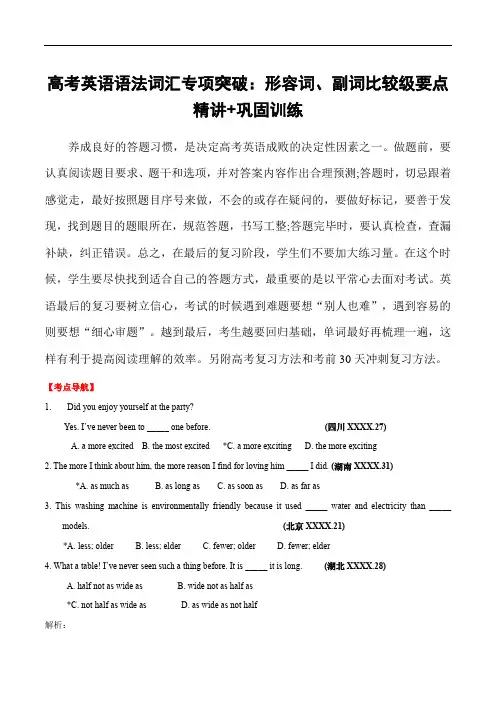
高考英语语法词汇专项突破:形容词、副词比较级要点精讲+巩固训练养成良好的答题习惯,是决定高考英语成败的决定性因素之一。
做题前,要认真阅读题目要求、题干和选项,并对答案内容作出合理预测;答题时,切忌跟着感觉走,最好按照题目序号来做,不会的或存在疑问的,要做好标记,要善于发现,找到题目的题眼所在,规范答题,书写工整;答题完毕时,要认真检查,查漏补缺,纠正错误。
总之,在最后的复习阶段,学生们不要加大练习量。
在这个时候,学生要尽快找到适合自己的答题方式,最重要的是以平常心去面对考试。
英语最后的复习要树立信心,考试的时候遇到难题要想“别人也难”,遇到容易的则要想“细心审题”。
越到最后,考生越要回归基础,单词最好再梳理一遍,这样有利于提高阅读理解的效率。
另附高考复习方法和考前30天冲刺复习方法。
【考点导航】1. ---- Did you enjoy yourself at the party?--- Yes. I’ve never been to _____ one before.(四川XXXX.27)A. a more excitedB. the most excited *C. a more excitingD. the more exciting2. The more I think about him, the more reason I find for loving him _____ I did. (湖南XXXX.31)*A. as much as B. as long as C. as soon as D. as far as3. This washing machine is environmentally friendly because it used _____ water and electricity than _____models.(北京XXXX.21)*A. less; older B. less; elder C. fewer; older D. fewer; elder4.What a table! I’ve never seen such a thing before. It is _____ it is long.(湖北XXXX.28)A. half not as wide asB. wide not as half as*C. not half as wide as D. as wide as not half解析:1.选C。
高考英语语法专题精讲精练-名词性从句
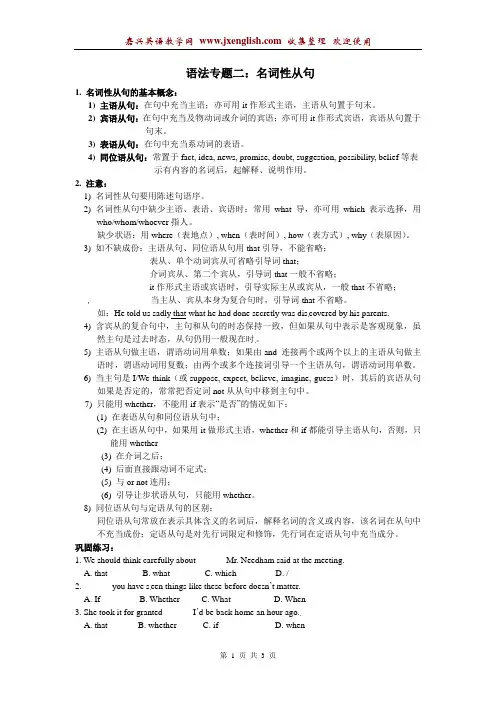
语法专题二:名词性从句1. 名词性从句的基本概念:1) 主语从句:在句中充当主语;亦可用it作形式主语,主语从句置于句末。
2) 宾语从句:在句中充当及物动词或介词的宾语;亦可用it作形式宾语,宾语从句置于句末。
3) 表语从句:在句中充当系动词的表语。
4) 同位语从句:常置于fact, idea, news, promise, doubt, suggestion, possibility, belief等表示有内容的名词后,起解释、说明作用。
2. 注意:1) 名词性从句要用陈述句语序。
2) 名词性从句中缺少主语、表语、宾语时:常用what 导,亦可用which表示选择,用who/whom/whoever指人。
缺少状语:用where(表地点), when(表时间), how(表方式), why(表原因)。
3) 如不缺成份:主语从句、同位语从句用that引导,不能省略;表从、单个动词宾从可省略引导词that;介词宾从、第二个宾从,引导词that一般不省略;it作形式主语或宾语时,引导实际主从或宾从,一般that不省略;当主从、宾从本身为复合句时,引导词that不省略。
如:He told us sadly that what he had done secretly was dis covered by his parents.4) 含宾从的复合句中,主句和从句的时态保持一致,但如果从句中表示是客观现象,虽然主句是过去时态,从句仍用一般现在时。
5) 主语从句做主语,谓语动词用单数;如果由and 连接两个或两个以上的主语从句做主语时,谓语动词用复数;由两个或多个连接词引导一个主语从句,谓语动词用单数。
6) 当主句是I/We think(或suppose, expect, believe, imagine, guess)时,其后的宾语从句如果是否定的,常常把否定词not从从句中移到主句中。
7) 只能用whether,不能用if表示“是否”的情况如下:(1) 在表语从句和同位语从句中;(2) 在主语从句中,如果用it做形式主语,whether和if都能引导主语从句,否则,只能用whether(3) 在介词之后;(4) 后面直接跟动词不定式;(5) 与or not连用;(6) 引导让步状语从句,只能用whether。
英语语法速成一般现在时精讲精练
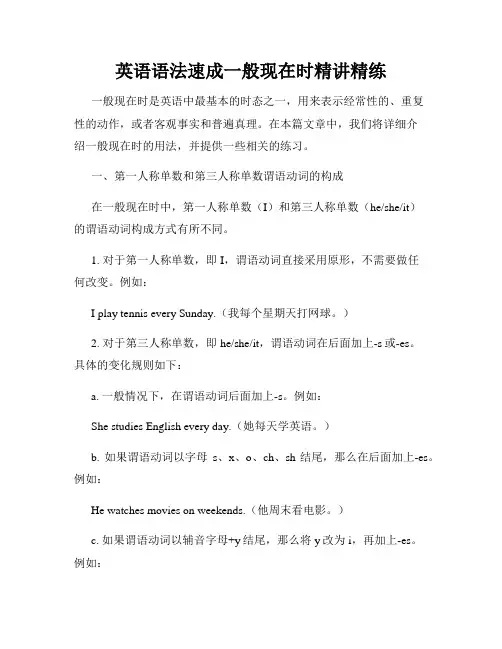
英语语法速成一般现在时精讲精练一般现在时是英语中最基本的时态之一,用来表示经常性的、重复性的动作,或者客观事实和普遍真理。
在本篇文章中,我们将详细介绍一般现在时的用法,并提供一些相关的练习。
一、第一人称单数和第三人称单数谓语动词的构成在一般现在时中,第一人称单数(I)和第三人称单数(he/she/it)的谓语动词构成方式有所不同。
1. 对于第一人称单数,即I,谓语动词直接采用原形,不需要做任何改变。
例如:I play tennis every Sunday.(我每个星期天打网球。
)2. 对于第三人称单数,即he/she/it,谓语动词在后面加上-s或-es。
具体的变化规则如下:a. 一般情况下,在谓语动词后面加上-s。
例如:She studies English every day.(她每天学英语。
)b. 如果谓语动词以字母s、x、o、ch、sh结尾,那么在后面加上-es。
例如:He watches movies on weekends.(他周末看电影。
)c. 如果谓语动词以辅音字母+y结尾,那么将y改为i,再加上-es。
例如:My dog barks loudly at night.(我的狗晚上叫得很大声。
)二、一般现在时的用法1.表示经常性或习惯性的动作:I often go jogging in the morning.(我经常早上慢跑。
)2.表示客观事实和普遍真理:The sun rises in the east.(太阳从东方升起。
)3.表示现状、感觉或状态:I feel tired after work.(工作后我感到疲劳。
)4.表示固定时间表中的动作:The train always arrives on time.(火车总是准时到达。
)三、一般现在时的练习现在我们来进行一些练习,以巩固对一般现在时的理解。
1. 填入适当的动词形式(第三人称单数):a. He __________ (watch) TV every day.b. The cat __________ (meow) at night.c. Mary __________ (teach) English at a school.d. The sun __________ (shine) in the sky.2. 根据括号中的提示,改写句子:a. She drinks milk every morning.(改为否定句)She ________ ________ milk every morning.b. They play basketball in the park.(改为疑问句)________ they ________ basketball in the park?c. My brother goes swimming on weekends.(改为一般疑问句)________ your brother ________ swimming on weekends?d. We have English class on Monday.(改为否定句)We ________ ________ English class on Monday.(答案)1. a. watches b. meows c. teaches d. shines2. a. doesn't drink b. Do; play c. Does; go d. don't have通过以上练习,希望能够帮助你更好地理解和使用一般现在时。
英语语法精讲精练与专项练习
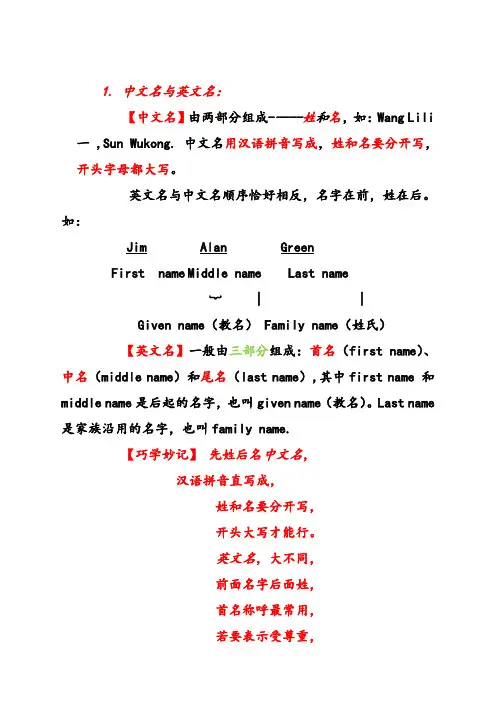
1. 中文名与英文名:【中文名】由两部分组成-----姓和名,如:Wang Lili一 ,Sun Wukong. 中文名用汉语拼音写成,姓和名要分开写,开头字母都大写。
英文名与中文名顺序恰好相反,名字在前,姓在后。
如:Jim Alan GreenFirst name Middle name Last name︸ | |Given name(教名) Family name(姓氏)【英文名】一般由三部分组成:首名(first name)、中名(middle name)和尾名(last name),其中first name 和middle name是后起的名字,也叫given name(教名)。
Last name 是家族沿用的名字,也叫family name.【巧学妙记】先姓后名中文名,汉语拼音直写成,姓和名要分开写,开头大写才能行。
英文名,大不同,前面名字后面姓,首名称呼最常用,若要表示受尊重,Mr.Mrs.Miss.Ms.姓前用[专项演练]()1.My full name is Jerry Harry Potter. My first name is_and my family name is_.A .Jerry HarryB .Jerry PotterC .Potter Jerry ()2.I’m Tom Green. You can call (称呼) me_A. Mr. TomB. Mr. GreenC. Green2.物主代词:在英语中,表示“你的,我的,他的,她的,它的,你们的,我们的,他们的”等意义的代词形式就叫物主代词。
物主代词是代词的所有格形式,用来表示物品的归属关系,即某物归某人所有。
【主格代词】在句中主要作主语,一般放在句首,说明是谁的情况。
I am a student.我是一名学生。
She is my sister.她是我的妹妹。
He is in China now.他现在在中国。
3.成都专升本语法精讲加练习“It”作形式主语和形式宾语的用法详解
“It”作形式主语和形式宾语“It”作形式主语和形式宾语的用法详解It作形式主语和形式宾语用法,是英语学习的主要语法项目之一。
无论是单项选择,还是完行填空,it用法始终是反复考查的重、热点之一。
现将it在特殊句型中作形式主语和形式宾语用法,进行如下归纳分析,以供学习参考。
一、It 用作形式主语当不定式(短语)、动名词(短语)或从句在某个句子中作主语时,为保持句子结构前后平衡,避免头重脚轻,因此常用it作形式主语置于句首,而将真正的主语放在句尾。
此时it只起先行引导作用,本身无词义。
e.g. It is wrong to tell a lie. (说谎是错误的。
) 〔It为to tell a lie的形式主语〕It is no use arguing about it. (争吵是没用的。
) 〔It为arguing about it的形式主语〕It is uncertain who will come. (谁要来还不确定。
) 〔It为who will come的形式主语〕It 作形式主语的常见句型:①It + be + 形容词+ to do sth. / doing / that ….e.g. It is very important to learn a foreign language. (学一门外语非常重要。
)It is useless crying over the spilt milk. (覆水难收。
)It was really surprising that she married a man like that.(她嫁给那样的男士真让人惊讶。
)②It + be +名词词组+ doing / that ….e.g. It is no good telling lies. (撒谎没好处。
)It is a pity that you didn’t go to see the film yesterday. (你昨天没看成那部电影真遗憾。
剑桥pet语法精讲精练
剑桥pet语法精讲精练剑桥PET语法精讲精练第一部分:剑桥PET语法精讲剑桥PET(Preliminary English Test)是剑桥大学考试委员会为英语学习者设计的一项英语能力测试。
PET考试主要测试学生在日常交流中的英语听、说、读、写能力。
在备考PET考试过程中,掌握语法知识是非常重要的一部分。
本文将对PET考试中常见的语法知识进行精讲,帮助考生更好地备考。
1. 时态在PET考试中,时态是一个常见的语法考点。
时态主要分为一般现在时、一般过去时、一般将来时等。
一般现在时用于表达经常性的动作或习惯;一般过去时用于表达过去发生的动作或状态;一般将来时用于表达将来要发生的动作或计划。
2. 被动语态被动语态是PET考试中的另一个重要的语法考点。
被动语态的结构为“be + 过去分词”,用于强调动作的承受者而不是执行者。
在使用被动语态时,要注意时态的变化和主动语态之间的转换。
3. 倒装句倒装句也是PET考试中的一个常见考点。
倒装句的结构为“助动词/情态动词 + 主语 + 动词”,用于强调句子中的某个部分或表示强烈的感情色彩。
在使用倒装句时,要注意主谓一致和疑问句的转换。
4. 定冠词和不定冠词定冠词和不定冠词在PET考试中也是常见的考点。
定冠词“the”用于特指某个事物;不定冠词“a/an”用于泛指某个事物。
在使用定冠词和不定冠词时,要注意单数和复数形式的变化。
第二部分:剑桥PET语法精练在进行PET考试的语法练习时,我们需要通过大量的习题来加深对语法知识的理解和掌握。
下面是一些PET语法练习题,供考生进行练习。
1. 完成句子a) I ______ my homework yesterday. (do)b) He _______ to the park every Sunday. (go)c) The letter ________ by Tom. (write)2. 改写句子a) He opened the door. (改为被动语态)b) They are playing football. (改为一般过去时)c) Never have I seen such a beautiful sunset. (改为陈述句)3. 按要求完成句子a) She has a dog. (改为否定句)b) Did you go to the party? (作否定回答)c) How often do you go swimming? (作肯定回答)第三部分:总结通过对剑桥PET语法的精讲和精练,我们可以更好地掌握PET考试中的语法知识。
大学英语语法精讲与练习
大学英语语法精讲与练习1.名词前的单位词(1. 3)a piece ofadvice/bread/cake/chalk/work/furniture/cloth/paper/ne ws/information/evidence/luggage/luck/businessan item of news/informationa drop of oil/water/whiskeyan article of clothing/lu ggage/furniturea bar of chocolate/soap/iron/goldan ear of wheat/ricea loaf of breada lump of coal/sugar/claya slice of bread/bacon/meat/cake表示成群的单位词a flock of birds/geese/pigeons/visitors/customersa herd of bees/ants/ starsa pack of thieves/wolves/hounds(猎狗)a bunch of keys/bananas/grapes/rosesa bundle of clothes/letters/firewooda crowd of robbers2. 主语与谓语的一致主语与谓语一致的原则:1)语法一致2)概念一致:谓语动词的单、复数形式取决于主语所表达的概念,而不取决于表面的语法标志。
The crowd were fighting for their lives.Three years in a strange land seems like a long time. 3)就近原则Here is a dictionary and a few books.Only one out of five were present.符合语法一致的几种情况(4)1)当主语为单数,虽后续with, along with, together with, as well as, as much as, no less than, more than, like, besides, but, except, in addition to引导的短语,谓语用单数。
英语语法精讲:强调句型it练习题
强调句型“六强调”It作引导词,用于强调结构,一般用来强调陈述句中除谓语动词以外的大多数句子成分,包括主语、宾语、状语和相关从句等,用来加强语气。
这种强调句型一般用“It be +被强调部分+that(who)+其它部分”来构成,常用于现在时和过去时。
如:I happened to meet Tom in the street the day before yesterday.It was Tom that I happened to meet in the street the day before yesterday.It was I who / that happened to meet Tom in the street the day before yesterday. It was in the street that I happened to meet Tom the day before yesterday.It was the day before yesterday that I happened to meet Tom in the street. I. 如果强调的部分是人,则人称代词须保持原来的形式,这时连接词可用who, whom代替that。
如:It is he who / that teaches us French.It is us who / whom / that he teaches French.II. 如果强调句子中的地点、时间或原因状语时,连接词仍用that,不能用where, when或why。
如:It is at the street crossing that I met one of my classmates that I had not seen for ages.It was last month that I took part in the Palace ball.我是在上个月参加的宫廷舞会(不能用when)。
- 1、下载文档前请自行甄别文档内容的完整性,平台不提供额外的编辑、内容补充、找答案等附加服务。
- 2、"仅部分预览"的文档,不可在线预览部分如存在完整性等问题,可反馈申请退款(可完整预览的文档不适用该条件!)。
- 3、如文档侵犯您的权益,请联系客服反馈,我们会尽快为您处理(人工客服工作时间:9:00-18:30)。
学习好资料欢迎下载大学英语语法精讲与练习1.名词前的单位词(1. 3)a piece of advice/bread/cake/chalk/work/furniture/cloth/paper/ne ws/information/evidence/luggage/luck/businessan item of news/informationa drop of oil/water/whiskeyan article of clothing/lu ggage/furniturea bar of chocolate/soap/iron/goldan ear of wheat/ricea loaf of breada lump of coal/sugar/claya slice of bread/bacon/meat/cake表示成群的单位词a flock of birds/geese/pigeons/visitors/customersa herd of bees/ants/ starsa pack of thieves/wolves/hounds(猎狗)a bunch of keys/bananas/grapes/rosesa bundle of clothes/letters/firewooda crowd of robbers2.主语与谓语的一致主语与谓语一致的原则:1 )语法一致2 )概念一致:谓语动词的单、复数形式取决于主语所表达的概念,而不取决于表面的语法标志。
The crowd were fighting for their lives.Three years in a strange land seems like a long time.3 )就近原则Here is a dictionary and a few books.Only one out of five were present.符合语法一致的几种情况( 4 )1 )当主语为单数,虽后续 with, along with, together with, aswell as, as much as, no less than, more than, like,besides, but, except, in addition to 引导的短语,谓语用单数。
An expert, together with some assistants, was sentto help in this work.Nobody but John and George was there.The teacher as well as the students was asked toattend the party.2 )主语由“a portion of, a series of, a king of etc.+ 名词”构成时,谓语用单数。
A series of pre-recorded tapes has been prepared forlanguage lab use.符合概念一致的几种情况1 )集合名词做主语时Our group are visiting the Museum next week.(我们全体成员)Our group is assigned to take the first bus.(我们小组)2 )名词词组中心词为表示度量、时间等的复数名词时,谓语动词采用单数形式Ten dollars is not enough.Fifty kilograms is not too heavy to carry.符合就近原则的几种情况1 )由并列连词or, either or, neither or, not only but also连接的两个主语 .Either you or I am late.Not only the students but also the teacher is goingto the film.2 )each and each, every and every, no and后 no续单数谓语动词。
Each book and each pen is found in its place.No teacher and no student is interested in it.3 )“ many a/more than one+ 单数名词做主语时,谓语为单数形式。
Many a student is having practice in this plant.More than one student was late for class this morning.3.形容词不具有比较意义的比较结构1) more/rather A than B: 与其说是B,不如说是AHe is rather diligent than clever. 说他聪明不如说他勤奋。
It is even more a picture than a poem. 这与其说是一首诗,到不如说是一幅画。
2) all the more因而更加:That ’ ll make the work all the more difficult.3) much more 更加,何况It ’difficults to understand his books, much more his lectures.4) much less 更不I didn’ t even see him, much less speak to him.5) none the less依然For all his years, he is none the less vigorous and active.6) other than不同于⋯,非⋯The truth is quite other than what you think.7) know better than很明白而不至于⋯Shecertainly knows better than to do it herself.8) none other than不是人而正是⋯It was none other than Miss Mary.部分同根形容的辨( 5. 5 )1) sensible可查觉得;明智的sensitive对敏感的sensational耸人听闻的He is sensible of the danger of his position.The old woman is very weak and sensitive to cold.It was a sensational news report.2) economic 有关经济的economical节俭的We should be economical in the use of our funds.The country is in a bad economic state.3) i ndustrial工业的industrious勤劳的It is an industrial country.The Chinese people are brave and industrious.4) h istoric 有历史意义的historical 有关历史的Where did the historic May 4 th Movement take place?Is it a historical novel?5) p ractical实际的,实践的practicable 可行的Now that able toyou are going to live in France, youmake practical use of your knowledge’ ll beofFrench.Is it practicable to try to grow crops in deserts?6) sociable和蔼可亲的social社会的;社交的We spent a sociable evening drinking.There are different opinions on various social questions.7) considerate 体贴的considerable 相当大的;值得重视的 /substantial Itwas considerate of you not to play piano while Iwas having a sleep.When her father died, Jane became head of a veryconsiderable business empire.8)continual略有间隙/隔的“连续不断”continuous没有间隙 / 隔的“连续不断”We’ ve had continuous hot weather for three weeks.I ’ mreally tired of your continual complaints.9)credible 可信的,可靠的credulous轻信的It ’ s hardly credible.She was so credulous that she could be easily fooled.与形容词构成固定搭配的介词( 5.8 )aboutanxious, crazy, curious, doubtful, eager, uneasyatbad, efficient, good, quick, slow, skillfulforanxious, available, insufficient, necessary, fit, grateful,ready,good,responsible,greedy,ripe,sorry, suitable, validfromabsent, distinctive, diverse, different, freeinabundant, confident, deficient, fortunate, major, rich,poorofafraid,ashamed,aware,capable,careful,certain, conscious confident,convinced,critical,doubtful, fond,full,greedy,guilty,ignorant,independent, proud,short,shy, sick,thoughtful,tired,typical, uncertain, worthy, regardlessondependent, hard, keentoaccustomed, obliged, applicable, available, benefit, convenient, dear, drink, equal, equivalent, essential, faithful, familiar, fit, grateful, harmful, helpful, identical, important , loyal, necessary , obvious,opposite, polite, preferable, proportional, relative, resistant, previous,senior,prior,sensitive,similar, superiorwithangry, comparable, consistent, content, familiar, identical, patient, pleased, popular, strict, satisfiedShe is very anxious about her husbandHe was slow at learning a language.I am very grateful for the help you have given me.All the main roads are now free of obstructions.The trees are abundant in fruits.They went camping, so as to be independent of innsand hotels.’ s health.。
